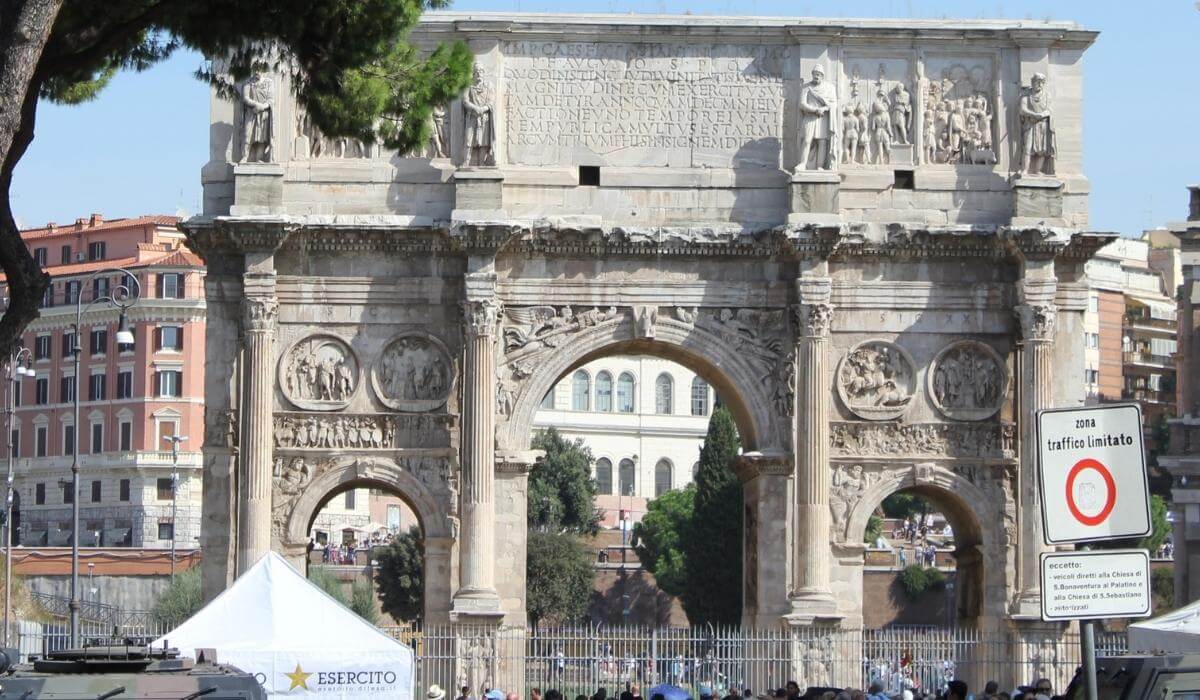
Arch of Constantine in Rome: History, Facts, Sculptures & How to Visit It
Curious about the Arch of Constantine in Rome and its fascinating past? This guide covers everything you need to know about how to visit the Arch of Constantine in Rome, including where to find it, how to get there, and if you need tickets to explore the site.
Standing proudly between the Colosseum and the Roman Forum, the Arcus Constantini is one of the most famous triumphal arches in the world. Learn about its rich history, the story behind its construction, and the detailed sculptures that decorate the monument.
Start your visit and discover why the Arch of Constantine remains such an iconic symbol of ancient Rome!
Contents
- 1 How to Visit the Arch of Constantine
- 2 Arch of Constantine Location & How to Get There
- 3 Arch of Constantine Opening Hours
- 4 Arch of Constantine Architecture Details
- 5 Arch of Constantine Facts You Won’t Hear from Your Guide
- 6 What Does the Arch of Constantine Represent to the Romans Today
- 7 The Religious Significance of the Arch of Constantin – Just What Did the Arch of Constantine Mean to the Romans?
- 8 History of the Arch of Constantine Rome Italy – Just What Is the Arch of Constantine?
- 9 Top Attractions near Arch of Constantine in Rome
- 10 Frequently Asked Questions
- 11 Conclusion
How to Visit the Arch of Constantine

The great news for visitors is that the Arch of Constantine is completely free to visit, no ticket is required! Unlike the monuments inside the Roman Forum, you don’t need a ticket to see it up close, the arch sits in a public area that’s open 24/7, making it one of the easiest monuments in Rome to admire.
That said, if you want to learn more about its history and symbolism, the best way is to visit it as part of a guided tour of the Colosseum and Roman Forum.
Most tours include a stop at the Arch of Constantine, where your guide will explain how it commemorated Emperor Constantine’s victory and how it reuses sculptures from earlier monuments, a fascinating glimpse into ancient Roman art and propaganda.
Here are the best ways to experience it:
- Free self-visit: Walk right up to the arch and admire its reliefs and inscriptions, no entry ticket needed.
- Colosseum & Roman Forum guided tour: These tours almost always include a stop at the Arch of Constantine. Prices start around €30 per person (check last price on this page), and you’ll gain deeper insight into its historical context.
- Premium small-group or private tour: For a more in-depth experience, opt for a tour that includes Colosseum arena access or Palatine Hill viewpoints. Prices start around €37 per person (see more details on this page), and the Arcus Constantini is one of the first highlights you’ll see.
Visiting Tip: Whether you visit by day or evening, the Arch of Constantine is one of the most photogenic spots in Rome, especially with the Colosseum in the background.
Arch of Constantine Location & How to Get There
You’ll find the Arch of Constantine just steps away from other major landmarks like the Arch of Titus, the Temple of Venus and Roma, and of course, the Colosseum itself. Thanks to its central location between the Colosseum and the Palatine Hill, you’ll most likely pass right by it while exploring the area, it’s impossible to miss!
How to get to the Arch of Constantine:
- By metro: Take Line B (the blue line) and get off at Colosseo station. As soon as you exit, you’ll see the Colosseum right in front of you, and just beside it stands the Arch of Constantine, less than a 2-minute walk away.
- By bus: Several buses stop close to Via dei Fori Imperiali or Piazza del Colosseo, including lines 51, 75, 85, 87, and 118. From any of these stops, you can reach the Arch in under 5 minutes on foot.
- On foot: Roman Forum, Palatine Hill, or Piazza Venezia, it’s an easy and scenic walk. The Arcus Constantini sits right at the entrance of the Colosseum area, perfectly placed for photos with both ancient monuments in the background.
You can check the exact location of the Arch of Constantine and get walking directions directly on Google Maps below.
Arch of Constantine Opening Hours
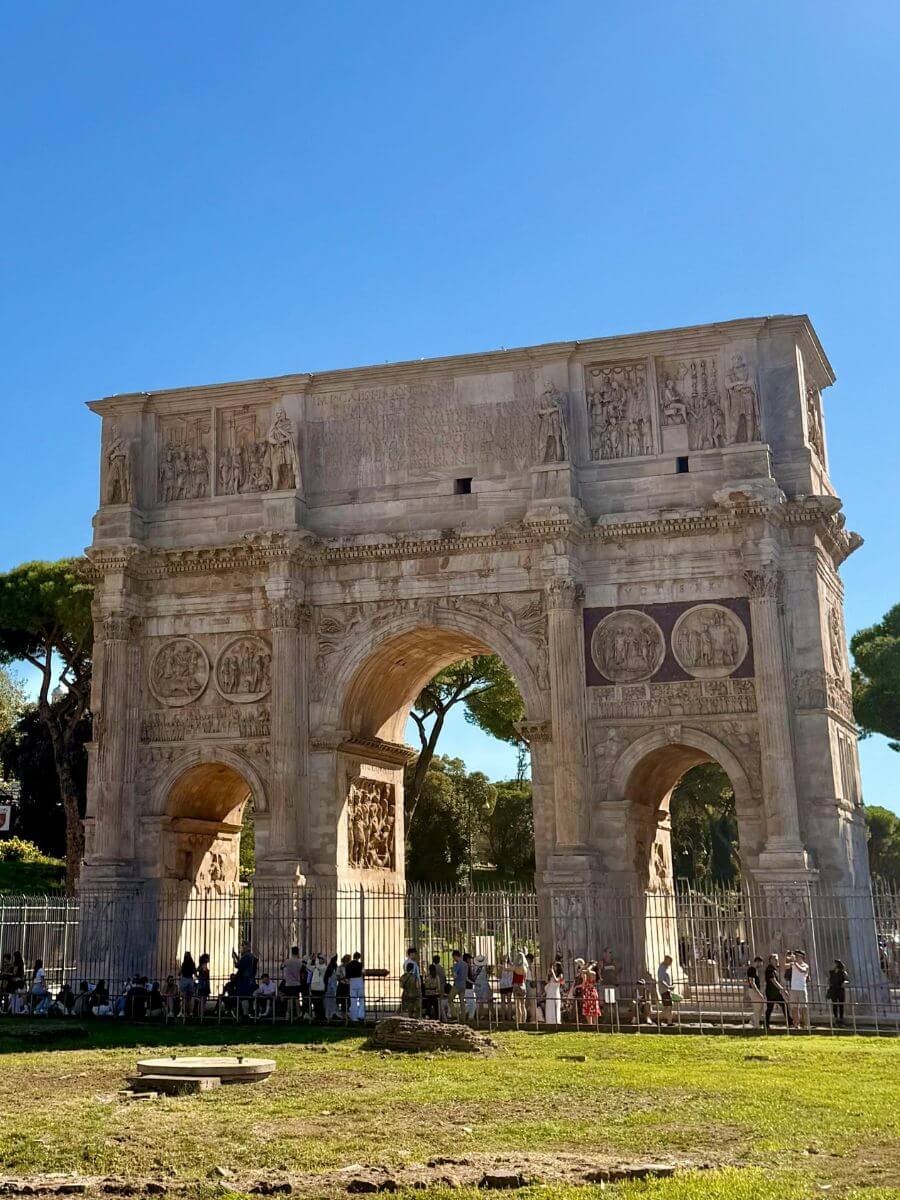
The Arch of Constantine is one of the few ancient monuments in Rome that can be admired freely at any time of day.
However, if you’d like to view the Arcus Constantini from the Colosseum archaeological zone (for example, when visiting the Colosseum, Roman Forum, and Palatine Hill complex), the opening hours follow those of the Parco archeologico del Colosseo:
- From late March to late August: 8:30 am – 7:15 pm
- From late August to late October: 8:30 am – 6:30 pm
- From late October to mid-February: 8:30 am – 4:30 pm
- From mid-February to late March: 8:30 am – 5:30 pm
- (Last entry is usually one hour before closing time.)
Closed on: December 25 and January 1.
Arch of Constantine Architecture Details

The Constantine Monument sure is impressive. Rather than staring at it for a few seconds without understanding its significance, let’s take a look at some of the details on the arch.
Arch of Constantine Dimensions
It stands at just under 70 feet high and 85 feet wide. It is also an impressive 24 feet in depth!
Just how they managed to build structures like this back in the day is astounding enough in itself. The fact that it is still standing is also of course pretty cool!
Building Materials – What Is the Arch of Constantine Made Of?
The main body of the arch is made of a white marble with blue hues – known as Proconnesian marble – which forms the three arches. Flanking the three arches are four Numidian Yellow columns.
Standing back and looking at the structure you’ll likely wonder to yourself “how was the Arch of Constantine built to stand the test of time?” But Roman engineering has truly proved its endurance in things like the Colosseum and the Arch of Constantine.
It is also understood that the builders added previously existing parts of other arches or structures to make the final piece.
The Tribute to Constantine on the Arch of Constantine Rome Italy
On the top of the arch is the engraved tribute to Emperor Constantine:
To the emperor Flavius Constantine the Great
pious and fortunate, the Senate and People of Rome
because by divine inspiration and his own greatness of spirit
with his army
on both the tyrant and all his
faction at once in rightful
battle he avenged the State
dedicated this arch as a mark of triumph.
Scenes Depicted on the Arch of Constantine
The Arch of Constantine South Side depicts military scenes, while the North Side of the arch shows civil scenes. The intricate details could have you staring at the arch for hours!
The Battle of the Milvian Bridge is of course heavily depicted on the scenes, being the key reason for the build, however there are other scenes including the siege of Verona depicted.
There is also a part showing Constantine addressing onlookers in the Forum Romanum.
Arch of Constantine Facts You Won’t Hear from Your Guide
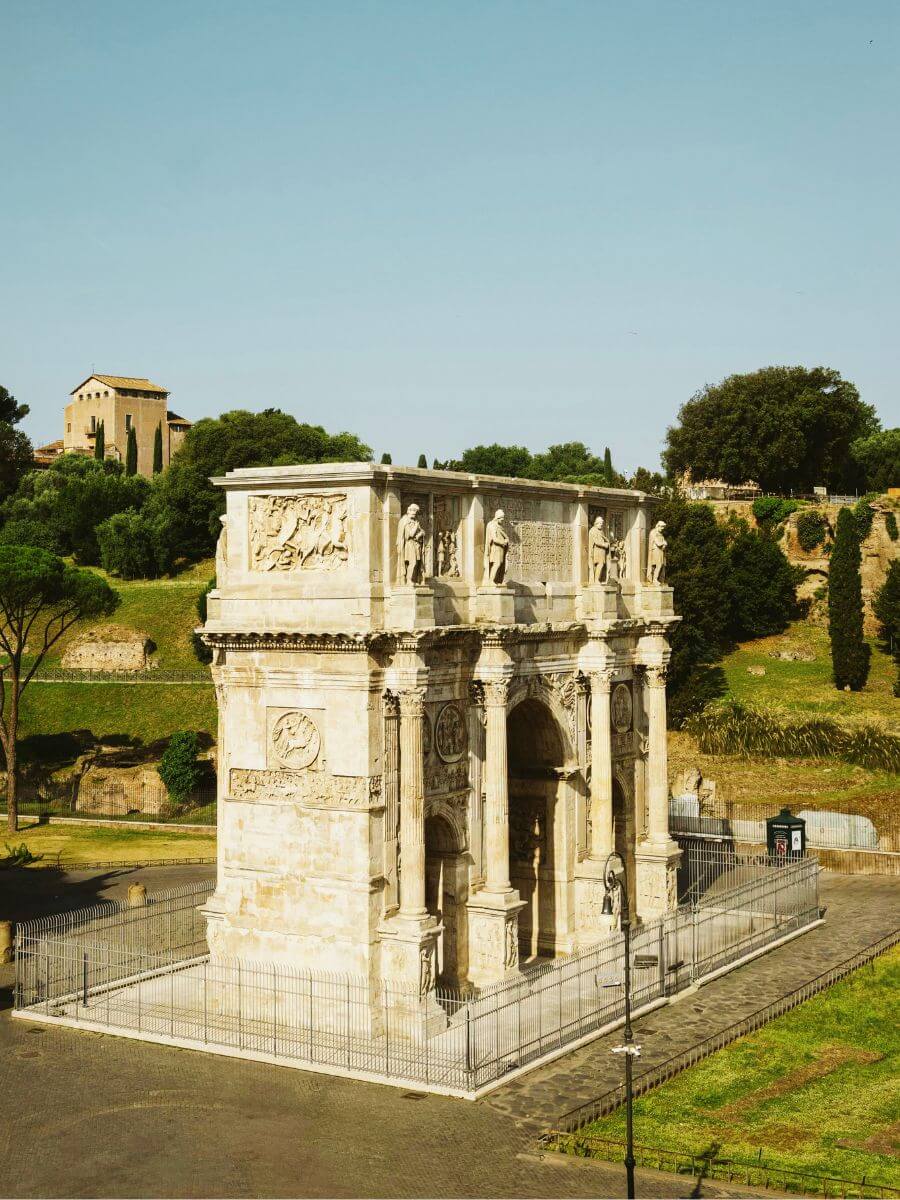
Let’s check out some facts about the Arch of Constantine that you can use to impress your travel companions!
Even if you choose not to hire a tour guide when in Rome, you can still get enjoy the details of this structure:
- Despite being heralded as marking the beginning of official Christianity in Rome, there are actually no Christian symbols or designs on the Arch of Constantine.
- This is the largest triumphal arch still remaining in Rome today.
- Even though the Arch of Constantine is celebrated as the structure that marks the journey to conversion to Christianity for Constantine, but it is actually thought that he only converted to Christianity on his deathbed.
What Does the Arch of Constantine Represent to the Romans Today
Modern day Romans may not think much about the arch on a day to day basis, but it's image is as iconic as the Colosseum.
Recently renovated, the arch stands for the old power of the Roman Empire, the Christian beliefs of the population in general, and the overall strength of Rome throughout the edges.
Coupled with the historical value associated with this and other similar triumphal arches in Rome, this architectural gem holds huge weight in terms of Rome’ cultural heritage.
The Religious Significance of the Arch of Constantin – Just What Did the Arch of Constantine Mean to the Romans?
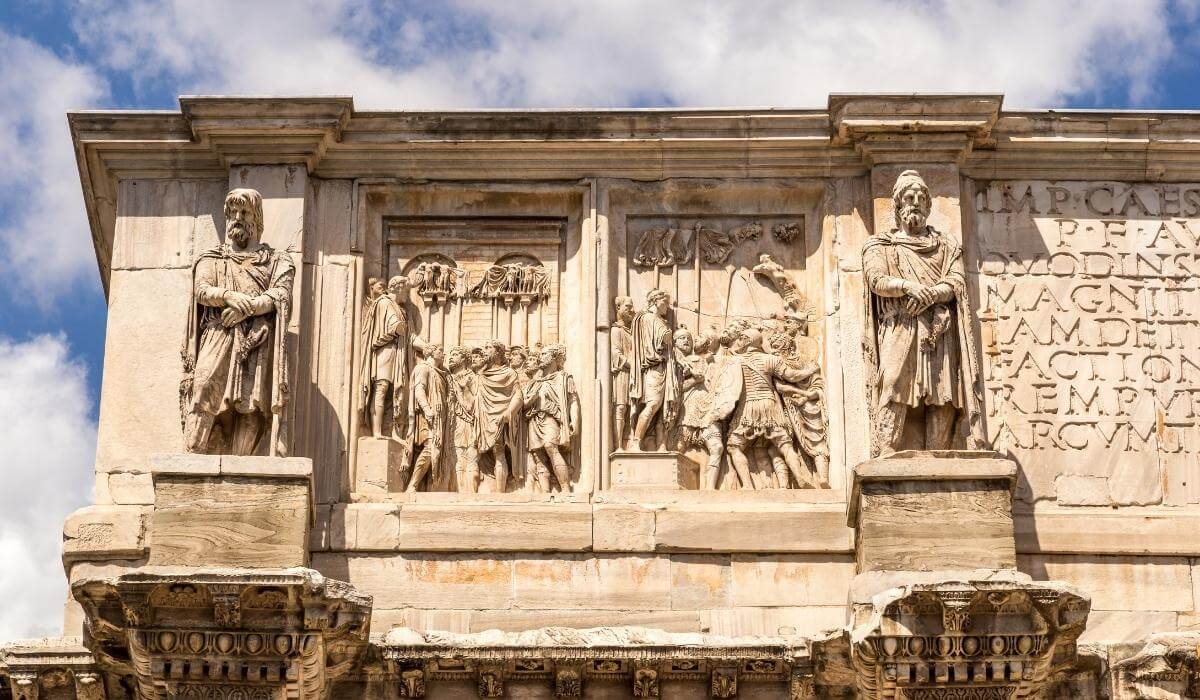
The Arch of Constantine is hugely significant in terms of early Roman Christianity. Constantine credited his victory in the Milvian Bridge Battle to God.
It says that this event set Constantine off on his journey to Christianity, although this fact is disputed. What is clear however is that the persecution of Christians did stop under his rule.
The long and drawn out period of hardship for believers ended, and eventually the official religion of the Roman Empire became Christianity.
As a result, the Arch of Constantine’s significance comes from the fact that it stands for the origin of the Chritian faith in the Roman Empire.
History of the Arch of Constantine Rome Italy – Just What Is the Arch of Constantine?
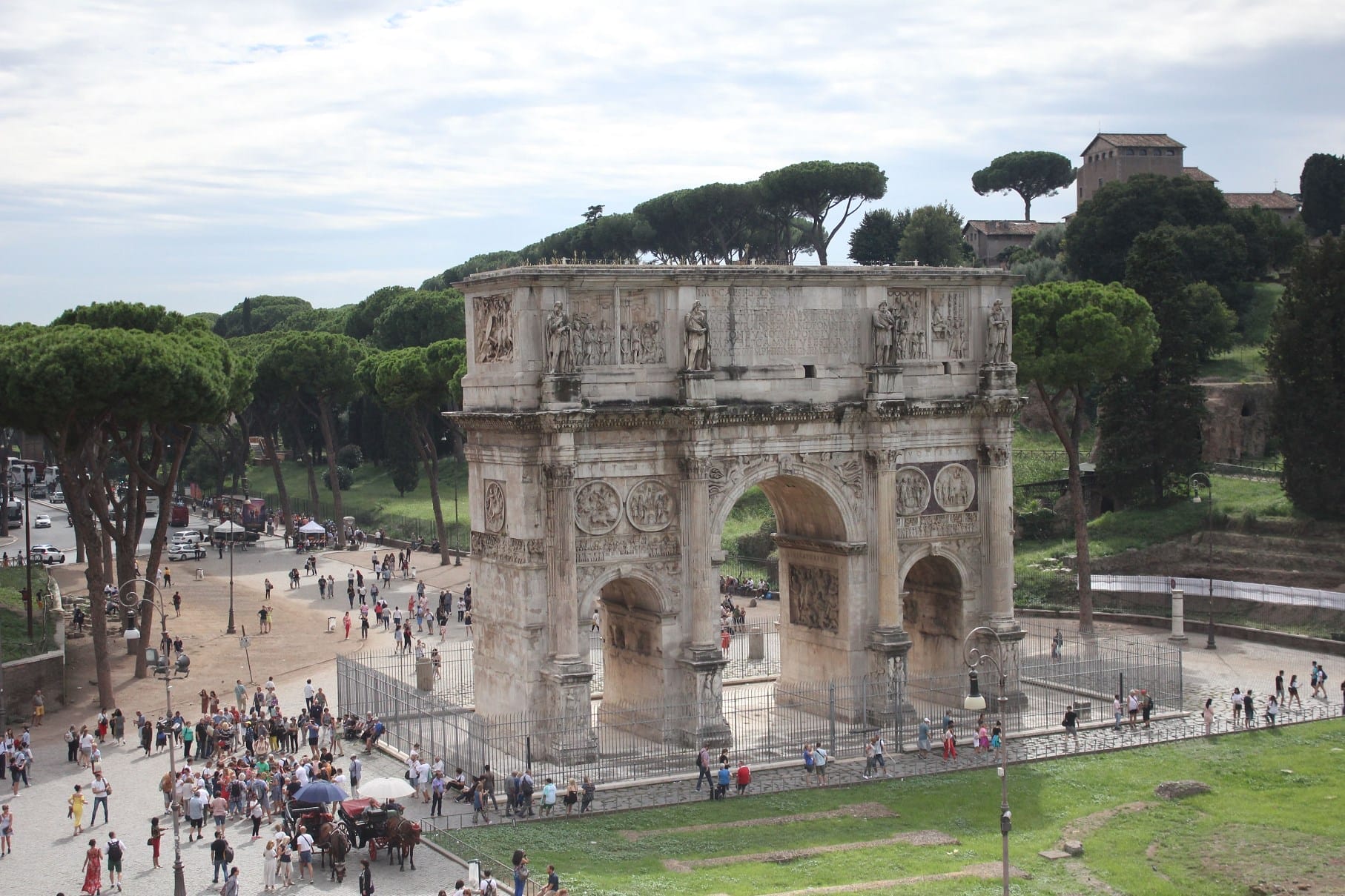
In 312 AD, Emperor Constantine won the battle of the Milvian Bridge against Emperor Maxentius. Maxentius drowned in the river, and Constantine came closer to being the sole Emperor.
To celebrate this victory, the Constantine Monument was designed and erected near to the Colosseum. It sits over the Via Triumphalis – this is the road down which the victors from Roman battles would parade. Completed in 315, the arch is a striking feature in modern Rome.
Although it is dedicated to the emperor whose name was given to Constaninople – now Istanbul – the Arch of Constantine architect pieced together remnants of other key arches dedicated to the likes of Hadrian or Trajan in a hodge podge architectural masterpiece.
So you are looking at an amazing melange of history as you gaze up.
Top Attractions near Arch of Constantine in Rome
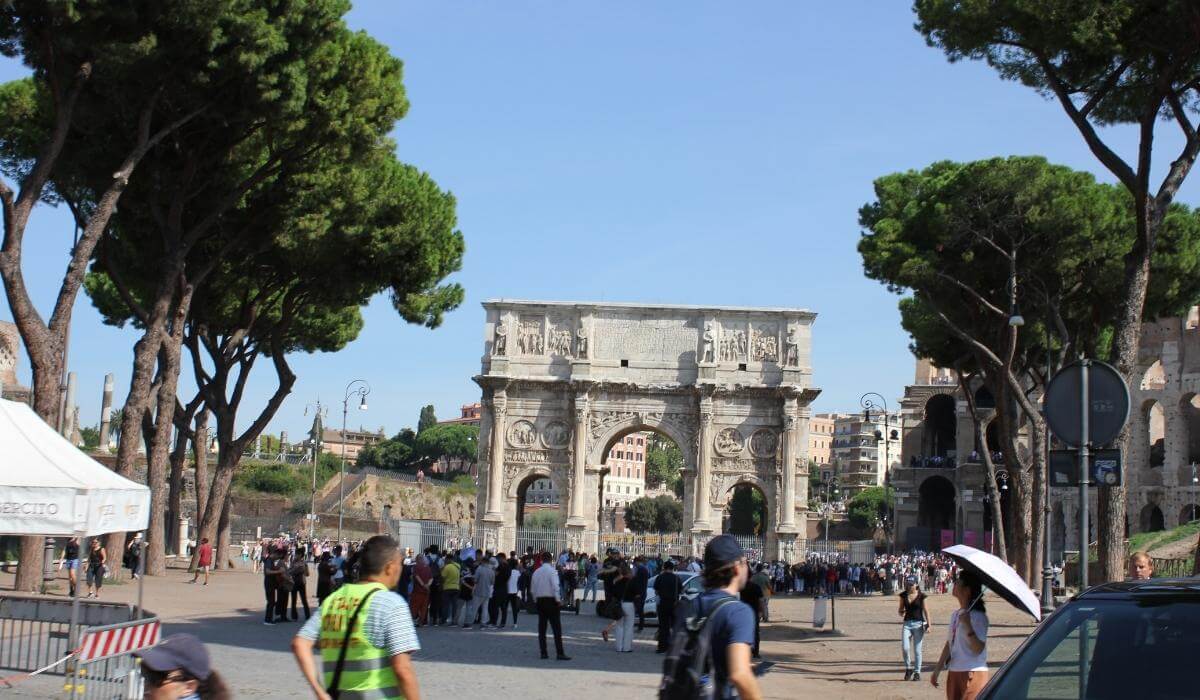
After you’ve admired the Arch of Constantine up close, don’t leave too quickly. This part of Rome is full of famous monuments, viewpoints, and historic sites.
Most are just a short walk away, so it’s easy to turn a quick stop into a full sightseeing route.
- Colosseum – Just steps from the Arch of Constantine, the Colosseum is impossible to miss. Walk around the outside to enjoy the scale, then go inside to imagine gladiator fights and roaring crowds. Whether you join a tour or explore on your own, it’s a must-see.
- Roman Forum – Cross the street and you’re in what was once the center of Roman public life. Stroll past temples, arches, and ancient streets where leaders debated and celebrated victories. Take your time here; almost every ruin has a story behind it. Get Colosseum, Roman Forum and Palatine Hill guided tour here >>
- Palatine Hill – Behind the Arch, Palatine Hill offers ruins, gardens, and some of the best views over the Roman Forum and Circus Maximus. Wander through the remains of imperial palaces and picture how emperors once lived high above the rest of the city.
- Temple of Venus and Roma – Between the Arch and the Colosseum, this large temple area is easy to overlook. Stop to see its platforms and scattered columns, then turn around for a great photo spot. You’ll get beautiful views of both the Colosseum and the Arch of Constantine.
- Domus Aurea – A short walk uphill brings you to the remains of Nero’s “Golden House.” Today it’s an underground archaeological site you visit with a guided tour, often using virtual reality. It offers a very different, more intimate look at ancient Rome.
- Ludus Magnus – Just beyond the Colosseum are the ruins of the main gladiator school. From the street you can look down into training courtyards and corridors that once connected to the arena. It’s a fascinating “behind-the-scenes” stop after visiting the Colosseum and Arch.
- Basilica di San Clemente – A few minutes’ walk away, this unique church is built on several layers of history. Visit the decorated upper church, then go down to older churches and Roman rooms below. It’s peaceful, atmospheric, and a nice break from the crowds.
With so many attractions around the Arch of Constantine, you can easily spend hours exploring this compact, history-packed corner of ancient Rome.
Frequently Asked Questions

Why was the Arch of Constantine built?
It was built to commemorate Constantine’s victory in battle at Milvian Bridge.
When was the Arch of Constantine built?
The arch was completed in 315 AD.
Who made the Arch of Constantine?
The Roman Senate requested and funded the build of this monument.
How tall and how old is the Arch of Constantine?
It stands at 69 feet tall and it was built in 315 AD. You do the math!
Can you get married by the Arch of Constantine?
We did a quick check – you can at the very least get your pictures taken at this amazing place!
Conclusion
This is an epic arch that shouldn’t be missed when you are visiting Rome. And since the Arch of Constantine is so close to the Colosseum you have no excuse but to see it. Now, check out the rest of this site to help you plan your trip to the Colosseum.
If you are opting for a city pass we have plenty of information to help you make your decision, including our Turbopass Rome Review and our Roma Pass vs Omnia Card guide.
Fanny, an ardent admirer of ancient history and architecture, has been fascinated by the Colosseum since her first visit to Rome in 2012. As a key contributor to the Visit Colosseum Rome blog, she brings her passion for the Roman Empire’s monumental legacy to every article and guide.
